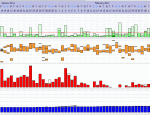Hi BigLou!
I have some thoughts.
BigLou wrote:Why do I have increased flow limitations with the increase in pressures?
You seem to use a lot of air (your flow waveform is wide). From my experience moving a lot of air irritates the airway passage (dries, cools, less CO2 frustrates circulation and metabolism). So now, if you raise pressure you will tend to use more air, further irritate the airway passage which will cause more flow limitations which will raise the pressure (+loop . . .).
BigLou wrote:Can it cause sleep fragmentations or am I barking up the wrong tree!?
In your case, apparently so.
As I look at the entire night you have a few bumps to start with a fairly major change at around 2:20a.m. The little narrowing of the waveform makes me think that the event eventually may have produced an arousal or awakening. Things quite down, indeed are fairly quiet but by 5:10 or so your breathing appears to take off and become unstable. I think the increased flow limitations are consistent with unstable breathing in this context. And, indeed, it would appear they resulted in a full awakening (probably a bathroom break for you). The time to the next batch of unstable breathing is reduced in your second set on the machine.
Our breathing control appears to take the inputs from our O2 and CO2 sensors and then adds in a factor from our level of central nervous system activation which then drives our muscles to breath. It is intended, so they think, to be a negative feedback loop. Obstructive Sleep Apnea (OSA) upsets this system in ways we do not yet understand. What we do know is that the process is upset. If the gain of the system goes above one, you have unstable breathing. It can go the range of simply breathing levels considerably above what is necessary for good metabolism, to periodic breathing where the breathing level oscillates as the system tries to find stability, to full fledged hypocapnic central apnea.
It appears that your high breathing levels result in arousals – which increase central nervous system activation, which results in heaver breathing - . . . - until the breathing becomes fully destabilized and fully awakens you.
BigLou wrote:Am afraid to increase the top range due to aerophgia and what not.
After reading up on unstable breathing I am more afraid of what it does to me than I am of OSA!! I would not use APAP if it were me. You might even consider trying less pressure on CPAP.
BigLou wrote:No events usually slip thru but am just concerned about the sleep quality. I feel OK in the a.m. but not GREAT even with such low AHI's. Was titrated @ 10 straight CPAP 4 months ago. Decided myself to experiment into APAP. AHI's have been lower since.
My pressure, proscribed about nine years ago, has been bumped up twice. Recently weight loss and other changes brought me to the point where I could see unstable breathing creeping into my data. My AHI remained quite reasonable (under two) but I know what unstable breathing does to us (starves our cells, moves the brain into starve Peter to keep Paul going mode, it is not pretty). Unable to connect with medical help I decided to self titrate.
I tried Auto-PAP set to the extremes of the proscribed numbers (13 to 15). Snoring kicked it to 15 and I know that snoring is one of the signs of unstable breathing. When my nose stuffs up anymore I take it as a sign to breath less – which consistently clears it up. No tissue required. Auto-PAP would not work for me.
I then started at 13 cm/H2O and looked at my data for at least a week each time – deciding to lower another 1 cm/H2O – until – some two months later I raised it from 7 back to 8 cm/H2O were it will stay until I see good reason to move it.
As I reduced the pressure the average AHI (over a week of data) stayed under two. Since I use techniques to help repair some of the damage to my breathing system which cause me to breath less and slower sometimes the events are false and simply the result of breathing less often. So that is even better than it looks.
I decided to go with 8 because at 7 I did see very real looking apnea flow waveforms and because we are going into a time and season where I expect to see more inflammation (and possible weight gain) in my body so the higher pressure – well – I have considerable “head room” before unstable breathing I know from the process of finding where OSA occurs, pressure wise.
If I were you I would:
1. Reduce Stress!
2. Go back to using CPAP.
3. Raise the head of my bed a couple of inches. Concrete bricks from a building suppy store do this nicely weighing in at less than five dollars for the pair. This should lessen your need for pressure and my help with the tendency for aerophgia as well.
4. If the above yields AHI less than 2 you might consider going lower in small steps as I mention above. Note that I spent 16 days trying out 13 and average a bit over nine days a try for each pressure as I moved pressures. Move slow looking at the data with care.
5. I do regular aerobic and interval training exercise in an effort to help my breathing reflexes work better. I really do believe it helps. I tried for about three months to connect with good medical care all that time at pressure which was much higher than it should have been. The exercise helped me keep my wits and saved my health!
Have a great week!
Todzo


















